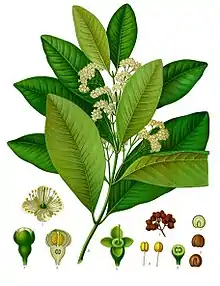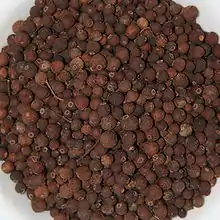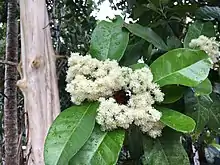Allspice
Allspice, also known as Jamaica pepper, myrtle pepper, pimenta, or pimento,[lower-alpha 1] is the dried unripe berry of Pimenta dioica, a midcanopy tree native to the Greater Antilles, southern Mexico, and Central America, now cultivated in many warm parts of the world.[2] The name "allspice" was coined as early as 1621 by the English, who valued it as a spice that combined the flavours of cinnamon, nutmeg, and clove.[3]
| Allspice | |
|---|---|
 | |
| Illustration of twig, flowers, and fruits | |
| Scientific classification | |
| Kingdom: | Plantae |
| Clade: | Tracheophytes |
| Clade: | Angiosperms |
| Clade: | Eudicots |
| Clade: | Rosids |
| Order: | Myrtales |
| Family: | Myrtaceae |
| Genus: | Pimenta |
| Species: | P. dioica |
| Binomial name | |
| Pimenta dioica | |
| Synonyms[1] | |
|
List
| |
Several unrelated fragrant shrubs are called "Carolina allspice" (Calycanthus floridus), "Japanese allspice" (Chimonanthus praecox), or "wild allspice" (Lindera benzoin).
Production

Allspice is the dried fruit of the Pimenta dioica plant. The fruits are picked when green and unripe and are traditionally dried in the sun. When dry they are brown and resemble large, smooth peppercorns. Fresh leaves are similar in texture to bay leaves and similarly used in cooking. Leaves and wood are often used for smoking meats where allspice is a local crop.
Care must be taken during drying to ensure that volatile oil, such as eugenol, remains in the end products.[4]
Uses
Allspice is one of the most important ingredients of Caribbean cuisine. Under the name 'pimento', it is used in Jamaican jerk seasoning, though in principle the wood is used to smoke jerk in Jamaica. In the West Indies, an allspice liqueur is produced under the name "pimento dram". In Mexican cuisine, it is used in many dishes.[5]
Allspice is also indispensable in Middle Eastern cuisine, particularly in the Levant, where it is used to flavour a variety of stews and meat dishes, as well as tomato sauce.[6] In Arab cuisine, for example, many main dishes use allspice as the only spice.
In northern European and North American cooking, it is an ingredient in commercial sausage preparations and curry powders, and in pickling.
In the United States, it is used mostly in desserts, but it is also responsible for giving Cincinnati-style chili its distinctive aroma and flavor. Allspice is commonly used in Great Britain, and appears in many dishes, including cakes and also in beauty products. In Portugal, whole allspice is used heavily in traditional stews cooked in large terracotta pots in the Azores islands.
Cultivation and trade
_W_IMG_2432.jpg.webp)
The allspice tree, classified as an evergreen shrub, can reach 10–18 m (33–59 ft) in height. Allspice can be a small, scrubby tree, quite similar to the bay laurel in size and form. It can also be a tall, canopy tree, sometimes grown to provide shade for coffee trees planted underneath it. It can be grown outdoors in the tropics and subtropics with normal garden soil and watering. Smaller plants can be killed by frost, although larger plants are more tolerant. It adapts well to container culture and can be kept as a houseplant or in a greenhouse.
At the time allspice was encountered by Christopher Columbus during his second voyage to the New World, it was found only on the island of Jamaica, where the plant was readily spread by birds. Allspice was introduced into European and Mediterranean cuisines in the 16th century. To protect the pimenta trade, Jamaican growers guarded against export of the plant. Many attempts at growing the pimenta from seeds were reported, but all failed. Eventually, passage through the avian digestive tract, whether due to the acidity or the elevated temperature, was found to be essential for germinating the seeds, and successful germination elsewhere was enabled. Today, pimenta grows in Tonga and Hawaii, where it has become naturalized on Kauaʻi and Maui.[7] It continued to be grown primarily in Jamaica, though a few other Central American countries produced allspice in comparatively small quantities.[8]
See also
Notes
- Outside Jamaica, pimento typically refers to a red, heart-shaped sweet pepper.
References
- "The Plant List: A Working List of All Plant Species". Retrieved 19 August 2015.
- Riffle, Robert L. (1 August 1998). The Tropical Look: An Encyclopedia of Dramatic Landscape Plants. Timber Press. ISBN 978-0-88192-422-0.
- Oxford English Dictionary (2 ed.). Oxford, UK: Clarendon Press. 1 March 1989. ISBN 978-0-19-861186-8. Retrieved 12 December 2009.
- Branch, Legislative Services. "Consolidated federal laws of canada, Food and Drug Regulations". laws.justice.gc.ca. Retrieved 19 July 2018.
- Diana Kennedy, The Essential Cuisines of Mexico, 2009, ISBN 030758772X, passim
- Diane Kochilas, My Greek Table, 2018, ISBN 1250166373, p. 22
- Lorence, David H.; Flynn, Timothy W.; Wagner, Warren L. (1 March 1995). "Contributions to the Flora of Hawai'i III" (PDF). Bishop Museum Occasional Papers. 41: 19–58. ISSN 0893-1348. Retrieved 12 December 2009.
- Nancy Gaifyllia. "About.com Greek Food – Allspice". Archived from the original on 7 July 2011. Retrieved 26 June 2011.
External links
 Media related to Allspice at Wikimedia Commons
Media related to Allspice at Wikimedia Commons Data related to Pimenta dioica at Wikispecies
Data related to Pimenta dioica at Wikispecies The dictionary definition of allspice at Wiktionary
The dictionary definition of allspice at Wiktionary- "Pimenta dioica". Floridata Plant Encyclopedia.
- "Pimenta dioica". Plants of Hawaii. Hawaiian Ecosystems at Risk project (HEAR).
- "Allspice". Gernot Katzer's Spice Pages.
- "Allspice". Trade Winds Fruit.
- "Allspice". The Encyclopedia of Spices. Epicentre.com.
